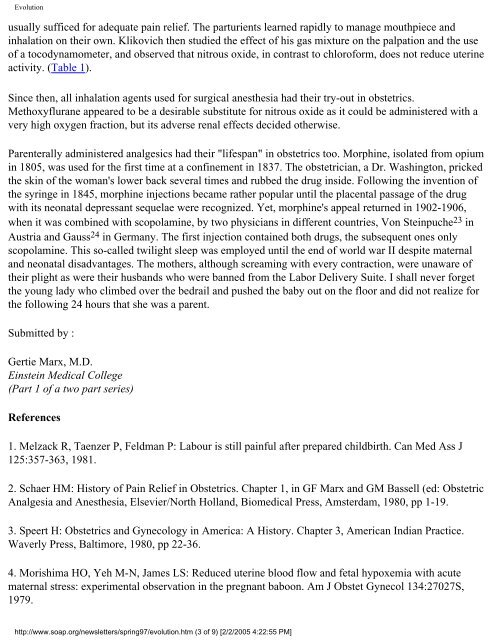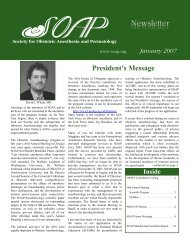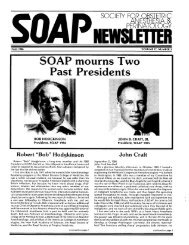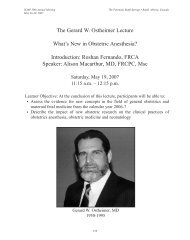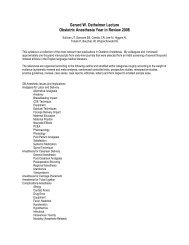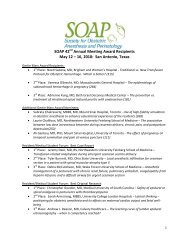SOAP Newsletter Highlights - Society for Obstetric Anesthesia and ...
SOAP Newsletter Highlights - Society for Obstetric Anesthesia and ...
SOAP Newsletter Highlights - Society for Obstetric Anesthesia and ...
Create successful ePaper yourself
Turn your PDF publications into a flip-book with our unique Google optimized e-Paper software.
Evolution<br />
usually sufficed <strong>for</strong> adequate pain relief. The parturients learned rapidly to manage mouthpiece <strong>and</strong><br />
inhalation on their own. Klikovich then studied the effect of his gas mixture on the palpation <strong>and</strong> the use<br />
of a tocodynamometer, <strong>and</strong> observed that nitrous oxide, in contrast to chloro<strong>for</strong>m, does not reduce uterine<br />
activity. (Table 1).<br />
Since then, all inhalation agents used <strong>for</strong> surgical anesthesia had their try-out in obstetrics.<br />
Methoxyflurane appeared to be a desirable substitute <strong>for</strong> nitrous oxide as it could be administered with a<br />
very high oxygen fraction, but its adverse renal effects decided otherwise.<br />
Parenterally administered analgesics had their "lifespan" in obstetrics too. Morphine, isolated from opium<br />
in 1805, was used <strong>for</strong> the first time at a confinement in 1837. The obstetrician, a Dr. Washington, pricked<br />
the skin of the woman's lower back several times <strong>and</strong> rubbed the drug inside. Following the invention of<br />
the syringe in 1845, morphine injections became rather popular until the placental passage of the drug<br />
with its neonatal depressant sequelae were recognized. Yet, morphine's appeal returned in 1902-1906,<br />
when it was combined with scopolamine, by two physicians in different countries, Von Steinpuche 23 in<br />
Austria <strong>and</strong> Gauss 24 in Germany. The first injection contained both drugs, the subsequent ones only<br />
scopolamine. This so-called twilight sleep was employed until the end of world war II despite maternal<br />
<strong>and</strong> neonatal disadvantages. The mothers, although screaming with every contraction, were unaware of<br />
their plight as were their husb<strong>and</strong>s who were banned from the Labor Delivery Suite. I shall never <strong>for</strong>get<br />
the young lady who climbed over the bedrail <strong>and</strong> pushed the baby out on the floor <strong>and</strong> did not realize <strong>for</strong><br />
the following 24 hours that she was a parent.<br />
Submitted by :<br />
Gertie Marx, M.D.<br />
Einstein Medical College<br />
(Part 1 of a two part series)<br />
References<br />
1. Melzack R, Taenzer P, Feldman P: Labour is still painful after prepared childbirth. Can Med Ass J<br />
125:357-363, 1981.<br />
2. Schaer HM: History of Pain Relief in <strong>Obstetric</strong>s. Chapter 1, in GF Marx <strong>and</strong> GM Bassell (ed: <strong>Obstetric</strong><br />
Analgesia <strong>and</strong> <strong>Anesthesia</strong>, Elsevier/North Holl<strong>and</strong>, Biomedical Press, Amsterdam, 1980, pp 1-19.<br />
3. Speert H: <strong>Obstetric</strong>s <strong>and</strong> Gynecology in America: A History. Chapter 3, American Indian Practice.<br />
Waverly Press, Baltimore, 1980, pp 22-36.<br />
4. Morishima HO, Yeh M-N, James LS: Reduced uterine blood flow <strong>and</strong> fetal hypoxemia with acute<br />
maternal stress: experimental observation in the pregnant baboon. Am J Obstet Gynecol 134:27027S,<br />
1979.<br />
http://www.soap.org/newsletters/spring97/evolution.htm (3 of 9) [2/2/2005 4:22:55 PM]


